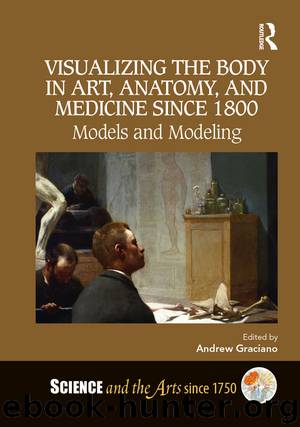Visualizing the Body in Art, Anatomy, and Medicine Since 1800 by Andrew Graciano;

Author:Andrew Graciano;
Language: eng
Format: epub
ISBN: 9781351004008
Publisher: Taylor & Francis (CAM)
Conclusion
In his short account on three-dimensional medical imaging, René van Tiggelen briefly asserted that stereoradiography “never had a great success” and “found itself overtaken by tomography.”98 While it is true that the precision of tomography made depth cues given by stereoscopy obsolete, it is difficult to observe any correlation between the rise of the former and the progressive decline of the latter. It should be stressed that there has never been a complete disappearance of the medium, despite the enormous technical progresses of tomography.99
The importance of stereoscopy for British radiography should be neither underestimated, nor reduced to its usefulness in medical diagnosis. Stereoradiography was also useful as a fashionable technique to collect and record information and to attract medical students and practitioners, as a means of self-promotion within the profession, and as a way to entertain and delight the eyes of even the most serious physicians. It satisfied the “desire to see beneath or around other bones and internal organs,” one which, as Kevles has pointed out, could not have been fully satisfied with a flat picture.100 Stereoradiography not only generated the three-dimensionality that X-rays were hitherto lacking, but also became an avatar of vision itself. The lack of interest radiographers had for understanding the physiological features of binocular vision explains why they were quite confident that stereoscopy was as “perfect as actual binocular vision” the same way an 1852 article could claim that stereoscopic vision “is but perfect vision.”101 Thanks to the pervading analogy between the human visual apparatus and the machine, stereoradiography seemed to provide something of a truer reality. Indeed, to make transparent the opacity of the human body, one needed an X-ray picture, but the latter remained a tangible object that mediated between sight and the tactile reality of the body’s interior. One sees, at the same time, the picture as an object and the picture as a representation. On the contrary, stereoscopic pictures require an instrument for proper observation, in such a way that by peering into the device, the apparatus is itself unseen, as though no longer noticed. With stereoradiography, the apparatus has seemingly vanished, leaving one with the curious and fascinating impression that it is one’s sight itself that penetrates the body, presaging our own comic-book fantasy of super-heroic X-ray vision as well as the real advancement and manifold application of virtual reality technology.
Download
This site does not store any files on its server. We only index and link to content provided by other sites. Please contact the content providers to delete copyright contents if any and email us, we'll remove relevant links or contents immediately.
Aircraft Design of WWII: A Sketchbook by Lockheed Aircraft Corporation(32139)
The Great Music City by Andrea Baker(30784)
Call Me by Your Name by André Aciman(19905)
The Art of Boudoir Photography: How to Create Stunning Photographs of Women by Christa Meola(18409)
The Secret History by Donna Tartt(18168)
Shoot Sexy by Ryan Armbrust(17559)
Plagued by Fire by Paul Hendrickson(17113)
Portrait Mastery in Black & White: Learn the Signature Style of a Legendary Photographer by Tim Kelly(16873)
Adobe Camera Raw For Digital Photographers Only by Rob Sheppard(16797)
Photographically Speaking: A Deeper Look at Creating Stronger Images (Eva Spring's Library) by David duChemin(16501)
Ready Player One by Cline Ernest(13996)
Pimp by Iceberg Slim(13781)
Bombshells: Glamour Girls of a Lifetime by Sullivan Steve(13689)
The Goal (Off-Campus #4) by Elle Kennedy(13203)
Art Nude Photography Explained: How to Photograph and Understand Great Art Nude Images by Simon Walden(12853)
Kathy Andrews Collection by Kathy Andrews(11328)
The Priory of the Orange Tree by Samantha Shannon(8619)
Thirteen Reasons Why by Jay Asher(8458)
The remains of the day by Kazuo Ishiguro(8399)
